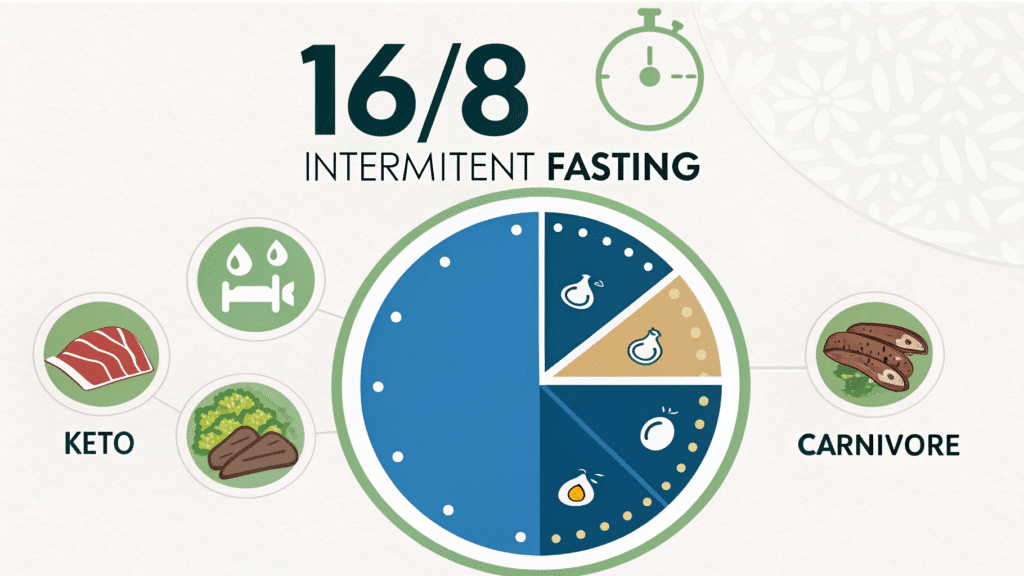The Ultimate Beginner’s Guide to Intermittent Fasting on Keto & Carnivore (+ Starter Tips!)
Table of Contents
I. Unlock Your Keto/Carnivore Potential with Intermittent Fasting
Feeling great on Keto or Carnivore but hearing buzz about Intermittent Fasting (IF)? Wondering if it’s the missing piece to accelerate your results or simplify your lifestyle?
If you’ve mastered the basics of low-carb eating through ketogenic or carnivore approaches, you may be curious about adding intermittent fasting to your routine. The combination can be powerful, but starting IF on top of Keto or Carnivore can seem confusing. When should you eat? How do you combine these approaches safely? What are the real benefits for low-carb eaters?
This comprehensive guide demystifies intermittent fasting specifically for Keto and Carnivore followers. We’ll cover the essential “what, why, and how,” providing a clear roadmap, common protocols, crucial tips (especially electrolytes!), and how to avoid beginner mistakes that can derail your progress.
Whether you’re looking to break through a weight loss plateau, simplify meal preparation, or explore the additional health benefits of fasting, this guide will help you integrate intermittent fasting into your low-carb lifestyle with confidence.
II. What is Intermittent Fasting, Really? (Beyond Simple Meal Skipping)
Intermittent fasting isn’t just skipping breakfast or randomly delaying meals. It’s a structured approach to eating that deserves proper understanding, especially when combined with ketogenic or carnivore diets.
Simple Definition
Intermittent fasting is an eating pattern, not a diet dictating what you eat. You cycle between periods of eating (your “eating window”) and voluntary fasting (your “fasting window”). Unlike traditional diets that focus on what foods to eat or avoid, intermittent fasting primarily addresses when to eat.
Key Distinction for Keto/Carnivore
When following a ketogenic or carnivore diet, you’re already eating nutrient-dense, low-carb foods; intermittent fasting simply optimizes when you consume them. The beauty of this combination lies in how these approaches complement each other metabolically.
The keto and carnivore diets naturally suppress hunger hormones due to their high fat and protein content. This makes the transition to intermittent fasting smoother than it would be on a standard high-carb diet, where hunger pangs and energy crashes are more common during fasting periods.
It’s Not Starvation
An important distinction: intermittent fasting is not starvation. It’s a controlled, intentional period without food, fundamentally different from dangerous chronic restriction. During proper intermittent fasting:
- Your body has ample stored energy to use during the fasting window
- You’re still meeting your nutritional needs during eating windows
- You’re giving your digestive system strategic rest periods
- You’re leveraging natural metabolic processes, not fighting against them
Focus
The primary focus of intermittent fasting is leveraging metabolic benefits during the fasting window while ensuring proper nutrition during eating periods. When combined with keto or carnivore approaches, you’re essentially optimizing both what and when you eat for maximum metabolic advantage.

III. The Keto/Carnivore + IF Advantage: Why Combine Them?
The synergy between intermittent fasting and low-carb approaches like keto and carnivore creates a metabolic powerhouse. Here’s why this combination works so well:
Deeper, Faster Ketosis
Intermittent fasting naturally depletes glycogen stores, helping keto dieters enter or deepen ketosis more efficiently. When your body has no incoming glucose or protein for several hours, it must turn to stored fat for energy, producing ketones.
For those already on keto or carnivore diets, this process is accelerated, as your body is already partially adapted to using fat as fuel. The fasting periods essentially “supercharge” your ketone production.
Enhanced Fat Burning
Combining low-carb fuel with fasting periods encourages your body to tap into stored fat more effectively. During fasting, insulin levels drop significantly, which sends a powerful signal to your body to release stored fat from adipose tissue.
This effect is amplified on keto/carnivore diets since your insulin levels are already lower due to minimal carbohydrate intake. The result? More efficient access to your fat stores for energy.
Appetite Regulation
The fat and protein satiety from keto/carnivore diets often makes fasting periods easier to manage. Many people report being surprised at how quickly hunger dissipates when they’re fat-adapted.
Ketones themselves have an appetite-suppressing effect, creating a virtuous cycle: fasting increases ketones, which reduces hunger, which makes fasting easier, which produces more ketones.
Potential for Increased Autophagy
Both intermittent fasting and ketosis are linked to autophagy – your body’s cellular cleanup process. This cellular maintenance process removes damaged cell components and recycles them, potentially offering longevity and health benefits.
The combination of fasting with nutritional ketosis may trigger more robust autophagy than either approach alone, though research in this area is still evolving, as this study in Cell Research suggests.
Metabolic Flexibility
Regular fasting trains your body to efficiently switch between fuel sources – from dietary fat/ketones during eating periods to stored body fat during fasting windows. This metabolic flexibility is a hallmark of optimal health and may provide advantages for long-term weight management.
Lifestyle Simplification
A practical benefit that many overlook: fewer meals to plan, prepare, and clean up after. For busy individuals, combining intermittent fasting with keto or carnivore eating means spending less time and mental energy on food, while potentially improving health markers.
IV. Popular Intermittent Fasting Schedules (Explained for Low-Carb Lifestyles)
There are numerous intermittent fasting protocols, but some work particularly well with ketogenic and carnivore approaches. Here are the most common fasting schedules, with special considerations for low-carb practitioners:
16/8 Method (16-Hour Fast, 8-Hour Eating Window)
The Crowd Favorite: This is the most popular starting point and for good reason – it strikes a balance between providing substantial fasting benefits while remaining practical for daily life.
Example: Stop eating at 8 PM, fast overnight and through the morning, start eating again at 12 PM (Noon) the next day. Your eating window is 12 PM – 8 PM.
Fit for Keto/Carnivore: This schedule allows for 2-3 satisfying, fatty meals within the window, which works well for those eating nutrient-dense, satiating foods. Many keto/carnivore followers naturally gravitate toward this pattern as their appetite regulation improves.
18/6 Method (18-Hour Fast, 6-Hour Eating Window)
Slightly More Advanced: This approach compresses eating into a shorter timeframe, extending the fasting benefits.
Example: Your eating window could be 1 PM – 7 PM, with the remaining 18 hours as fasting time.
Fit for Keto/Carnivore: Often means 2 larger meals rather than 3 smaller ones. The high fat content of keto/carnivore meals makes this comfortable for many adapted individuals, as the meals provide sustained energy through the extended fasting period.
20/4 & OMAD (One Meal A Day)
Advanced Protocols: These approaches condense all your daily nutrition into a very small window (4 hours) or even a single meal.
Important Note: These methods require careful planning to get adequate nutrition (especially protein and fat) in a very short window or single meal on keto/carnivore. For this reason, they’re not usually recommended for absolute beginners.
For experienced keto/carnivore eaters who want to try OMAD, focusing on nutrient-dense fatty cuts, organ meats, and adequate protein becomes even more crucial to ensure you’re meeting your nutritional needs.
Which Protocol is Best for You?
When starting out, it’s advisable to begin with the 16/8 method. This provides a sustainable introduction to fasting while still allowing sufficient time to consume adequate nutrition.
The most important factor is fitting the fasting schedule to your lifestyle and preferences:
- Consider your work schedule
- Factor in family meals and social obligations
- Account for workout timing
- Listen to your unique hunger signals
Remember that the “best” protocol is the one you can maintain consistently while feeling well and meeting your nutritional needs. Many experienced fasters eventually adopt a flexible approach, perhaps doing 16/8 on weekdays and more relaxed timing on weekends.
V. Your Step-by-Step Guide to Starting IF on Keto/Carnivore
Success with intermittent fasting on a low-carb diet comes down to proper implementation. Follow these steps to integrate fasting smoothly into your keto or carnivore lifestyle:
Step 1: Choose Your Starting Protocol (Ease In!)
Resist the temptation to dive into extended fasting right away. Even if you’re already fat-adapted on keto or carnivore, your body needs time to adjust to the fasting component.
Start with a 14/10 protocol (fast for 14 hours, eat within a 10-hour window) for at least 3-5 days. This might be as simple as stopping eating after dinner (7 PM) and having your first meal at 9 AM the next day.
Once this feels comfortable, move to 16/8, the standard entry-level protocol. Many people find they can transition to this schedule within a week, especially if they’re already fat-adapted.
Step 2: Define Your Eating Window
Look at your daily routine honestly. When is it easiest for you to skip a meal? For most people, breakfast is the logical choice because:
- Morning hunger often diminishes on keto/carnivore diets
- Social and work obligations around breakfast are typically fewer
- Fasting through the morning can provide mental clarity benefits
Common eating windows include:
- 11 AM – 7 PM
- 12 PM – 8 PM
- 10 AM – 6 PM
Choose what works best for your schedule and preferences. The key is consistency – your body adapts better to regular patterns.

Step 3: Master Your Fasting Window (Hydration & Electrolytes are KING!)
What you CAN have during the fasting window:
- Water (lots of it!)
- Plain black coffee (no cream, butter, or sweeteners)
- Plain unsweetened tea
- Sparkling water (unflavored)
What you MUST have: Electrolytes! This is non-negotiable, especially for keto and carnivore eaters. During fasting, your insulin levels drop further, causing increased sodium excretion by the kidneys.
Add unrefined salt to your water (¼-½ teaspoon in a large glass) or take a clean electrolyte supplement without sweeteners. This simple step prevents headaches, fatigue, dizziness, and the “keto flu” symptoms that can be amplified by intermittent fasting.
For more detailed guidance on electrolyte management, check out our comprehensive guide to carnivore diet electrolytes.

Step 4: Fuel Smart During Your Eating Window
A common mistake is undereating during your eating window. Remember, intermittent fasting is about timing, not caloric restriction. Focus on:
- Fatty cuts of meat (ribeye, chuck, salmon)
- Eggs with the yolks
- Butter, tallow, or other animal fats
- Getting enough protein (minimum 0.8g per pound of lean body mass)
Your meals should provide sufficient energy to fuel you through the next fasting period. This means emphasizing nutrient density and satiety.
When breaking your fast, start with a normal-sized keto or carnivore meal – no need for a tiny “breaking the fast” meal, but equally, don’t immediately gorge on a massive feast, which can cause digestive discomfort.
For meal inspiration, check out our carnivore diet meal ideas and keto carnivore recipes.
Step 5: Listen To Your Body & Adjust
While some initial adjustment symptoms are normal (mild hunger, slight energy fluctuations), persistent dizziness, extreme fatigue, or feeling unwell isn’t part of the process.
If you experience ongoing discomfort:
- Shorten your fasting window temporarily
- Increase salt/electrolyte intake
- Ensure you’re eating enough during your window
- Get adequate sleep and manage stress
Remember that fasting is a tool, not a competition. There’s no prize for the longest fast if it makes you feel terrible.
Important disclaimer: If you have underlying health conditions or take medication, consult with your healthcare provider before starting intermittent fasting.
Step 6: Be Consistent & Patient
It takes time for your body to adapt to any new eating pattern. Give yourself at least 2-3 weeks of consistent practice before judging the results or making major changes.
Track your experience in a simple journal, noting:
- Energy levels
- Hunger patterns
- Sleep quality
- Any symptoms
- Overall well-being
This information will help you fine-tune your approach over time.
VI. Avoiding Common Beginner Mistakes on Keto/Carnivore IF
Even with the best preparation, certain pitfalls trip up many beginners. Here’s how to navigate around the most common intermittent fasting mistakes:
Mistake 1: Fearing Fat
The Problem: Many newcomers reduce fat intake during their eating window, either from old diet habits or mistakenly thinking this will accelerate weight loss.
The Solution: Embrace healthy animal fats during your eating window. Undereating fat makes your fasting periods miserable and unsustainable. Remember that fat provides the energy that fuels your body through the fasting hours.
Practical tip: Add butter to your steak, choose fattier cuts of meat, and don’t trim the fat. Your future fasting self will thank you!
Mistake 2: Ignoring Electrolytes
The Problem: This is the #1 reason people feel bad and quit intermittent fasting, especially on keto/carnivore diets. Fasting accelerates sodium excretion, often leading to headaches, fatigue, dizziness, and irritability.
The Solution: Salt your water! Aim for at least 5,000-7,000mg of sodium daily while combining fasting with keto/carnivore. Don’t forget other electrolytes like magnesium and potassium as well.
Practical tip: Keep a premixed bottle of saltwater (¼ teaspoon in 20oz water) on hand for the mornings when you’re fasting. For a more comprehensive approach to supplementation, check our guide on carnivore diet supplements.
Mistake 3: Starting Too Aggressively
The Problem: The enthusiasm of beginners often leads to jumping into extended fasting protocols before proper adaptation.
The Solution: Start with shorter fasting periods (14-16 hours) and gradually extend as your body adapts. There’s no rush – the health benefits of intermittent fasting are available even with more moderate schedules when done consistently, as research in the New England Journal of Medicine suggests.
Practical tip: Set a realistic schedule and stick with it for at least two weeks before considering more advanced protocols.
Mistake 4: Compensating with Carbs/Junk
The Problem: Breaking the fast with non-keto/carnivore foods defeats many of the metabolic benefits you’re working to achieve.
The Solution: Plan your first meal back carefully. Focus on animal protein, healthy fats, and minimal carbs if you’re keto (or no carbs if carnivore). This maintains the metabolic advantages of both your fasting period and your low-carb lifestyle.
Practical tip: Prepare your break-fast meal in advance so you’re not making decisions while hungry. Having nutrient-dense options ready to go makes it easier to stay on track.
Mistake 5: Not Drinking Enough Water
The Problem: Dehydration exacerbates all potential side effects of fasting and can be mistaken for hunger.
The Solution: Aim for at least 3 liters of water daily, with added electrolytes. Hydration makes fasting substantially more comfortable and helps maintain energy levels.
Practical tip: Start your day with a large glass of water before your coffee or tea. Consider nutrient-dense liquids like bone broth during your eating window to support hydration and nutrition.
VII. Intermittent Fasting & Keto/Carnivore FAQ
Q: Will I lose muscle while combined fasting with keto/carnivore?
A: Unlikely, if you’re eating adequate protein and fat during your eating window and not chronically under-eating. Research shows intermittent fasting can actually boost Growth Hormone production, which helps preserve muscle tissue, as indicated in this study from the Journal of Clinical Investigation.
The key is ensuring sufficient protein intake (at least 0.8g per pound of lean body mass) during your eating window and maintaining resistance training if building/maintaining muscle is your goal.
Q: Can I exercise while fasting?
A: Yes, many people prefer it! Low to moderate-intensity activities like walking, light cardio, or even strength training can be performed while fasted. Benefits may include enhanced fat oxidation and improved metabolic flexibility.
If you’re planning more intense workouts while fasted:
- Ensure electrolyte intake before and after
- Listen to your body’s signals
- Consider timing intense workouts closer to your eating window, especially when first starting
For more on exercise timing with low-carb diets, check our guide on weight training on keto.
Q: What if I get really hungry during the fast?
A: First, ensure your previous meals were fatty enough. Mild hunger is normal and often passes after 20-30 minutes as your body adjusts to using stored fat.
Try these strategies:
- Drink water with a pinch of salt
- Black coffee or plain tea can help suppress appetite
- Stay busy with activities that engage your mind
- Remember that hunger often comes in waves rather than continuously increasing
If you experience ravenous, uncomfortable hunger regularly while fasting, it might indicate you need to adjust your eating window or increase fat/protein during your meals.
Q: How often should I do IF?
A: Many find daily 16/8 fasting sustainable long-term. Others prefer incorporating fasting 4-5 days per week, with more relaxed eating patterns on the remaining days.
There’s no single “correct” frequency – find what works for your lifestyle, goals, and wellbeing. The key is consistency with whatever pattern you choose rather than sporadic implementation.
Q: Is IF safe for everyone?
A: No, intermittent fasting is not suitable for everyone. You should avoid intermittent fasting or consult a healthcare provider first if you:
- Have a history of eating disorders
- Are pregnant or nursing
- Have certain medical conditions like diabetes
- Are underweight or malnourished
- Take medications that require food
- Are under 18 years of age
Safety and health always come first – intermittent fasting is a tool, not a requirement for keto or carnivore success.
VIII. Integrate Intermittent Fasting into Your Low-Carb Lifestyle
Intermittent fasting is a powerful eating pattern that pairs remarkably well with ketogenic and carnivore approaches. By strategically timing your meals, you can enhance the benefits of your low-carb lifestyle – from accelerated fat adaptation to simplified meal planning and potentially improved autophagy.
Starting is simple: Choose a gentle protocol (like 16/8), prioritize fat and electrolytes during your journey, stay hydrated, and listen to your body’s feedback. Remember that the most powerful approaches are the ones you can maintain consistently over time.
As your body adapts to this combined approach, many find a newfound sense of freedom from constant meal preparation and freedom from the energy rollercoaster that comes with frequent eating. The synergy between ketogenic/carnivore nutrition and intermittent fasting may be just what you need to take your health journey to the next level.
What’s your biggest question about starting IF on keto or carnivore? Ask in the comments!
Pin this guide for later reference!
Ready for meal ideas that work perfectly with intermittent fasting? Check out our carnivore diet meal plan or browse our collection of keto carnivore recipes.
Download our Quick IF Start Checklist PDF!
Enjoy, Review – We Value Your Opinion!
There are no reviews yet. Be the first one to write one.

